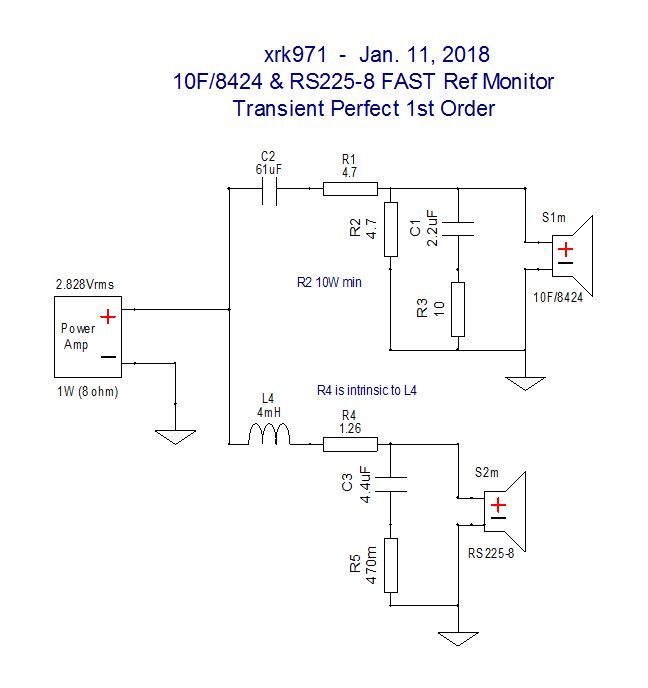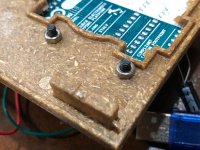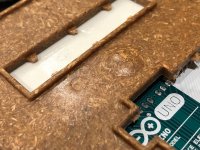Soundnovice,
The only thing you need to modify to taste is the padding (attenuation of the tweeter PS95) relative to the woofer. via ratio R1/R2. Just keep sum of R1 and R2 circa 10ohms and make R1 smaller and R2 bigger in order to get less attenuation of PS95-8. All else remains the same. Very flexible and adaptable XO as long as fullrange driver is 8ohms and at least 82dB sensitive.

Given that PS95-8 is about 2dB less sensitive than 10F/8424, you might try 3.3ohm for R1 and 6.7ohm for R2. I would even try the default 4.7R/4.7R as first cut.
R5/C3 is the notch to reduce the 7kHz breakup peaks on RS225-8 and is specific to this driver only. In fact, the key to this XO is teh RS225-8 - as it is the foundation. You can change various midtweets and djut padding but not the woofer.
The only thing you need to modify to taste is the padding (attenuation of the tweeter PS95) relative to the woofer. via ratio R1/R2. Just keep sum of R1 and R2 circa 10ohms and make R1 smaller and R2 bigger in order to get less attenuation of PS95-8. All else remains the same. Very flexible and adaptable XO as long as fullrange driver is 8ohms and at least 82dB sensitive.
Given that PS95-8 is about 2dB less sensitive than 10F/8424, you might try 3.3ohm for R1 and 6.7ohm for R2. I would even try the default 4.7R/4.7R as first cut.
R5/C3 is the notch to reduce the 7kHz breakup peaks on RS225-8 and is specific to this driver only. In fact, the key to this XO is teh RS225-8 - as it is the foundation. You can change various midtweets and djut padding but not the woofer.
Last edited:
It is interesting that they use recycled materials, but this product would be almost impossible to recycle again, with the wood chips glued to the plastic.
Here are some closeup photos so that you can see the fine molded details and it looks like particle board but feels smooth. It feels warmer and more sound absorptive than plain plastic. Arduino genuine stuff is made in Italy and they use nice components. It's good to give back to the arduino .org as they are providing a great service with their free and open platform.
My first project is to use arduino to program an ATTiny85 to do routine logic stuff like open and close relays for an industrial automation device that has to be absolutely reliable.
Attachments
some improvements:
tried harsch xover at 400hz in dayton dsp408. 1.25ms delay for the full range driver
with this, everything fell in place quite nicely. there seems to be easy transition between woofer and full range driver. yet to confirm with measurements, but the earlier 'fatigue' while listening with wrong 1st BW xover at 600hz is gone. i spent almost an hour listening to various genre and didn't feel tired. thats a good sign 🙂
next dragged the speakers away from rear wall by 1.5ft. the overlapping of bass notes reduced to good extent. but still couldn't move the speakers away from side walls for one of the speaker. i think for this reason bass is still not very 'fast' and also i think due to this volume at left speaker is more than that at right.
@xrk: with harsch, the requirement to invert the speaker boxes is not valid right? in dsp anyway we are setting 1.25ms delay. the drivers are not time aligned on the baffle. so should i add some more delay to compensate that? if so how do i calculate that. I am using ps95 driver.
tried harsch xover at 400hz in dayton dsp408. 1.25ms delay for the full range driver
with this, everything fell in place quite nicely. there seems to be easy transition between woofer and full range driver. yet to confirm with measurements, but the earlier 'fatigue' while listening with wrong 1st BW xover at 600hz is gone. i spent almost an hour listening to various genre and didn't feel tired. thats a good sign 🙂
next dragged the speakers away from rear wall by 1.5ft. the overlapping of bass notes reduced to good extent. but still couldn't move the speakers away from side walls for one of the speaker. i think for this reason bass is still not very 'fast' and also i think due to this volume at left speaker is more than that at right.
@xrk: with harsch, the requirement to invert the speaker boxes is not valid right? in dsp anyway we are setting 1.25ms delay. the drivers are not time aligned on the baffle. so should i add some more delay to compensate that? if so how do i calculate that. I am using ps95 driver.
Correct, if you had tweeter on top, and assume measurement point is coaxial with tweeter, then physical delay is less. In either case, delay is based approximately on the physical location of voice coils. It’s actually called the “acoustic center” but seems to correlate well with how deep the cone is and where voice coil attaches. Voice coil of PS95 is recessed about 2.5cm from bezel. Voice coil of RS225 is maybe 10cm recessed back. So your starting position tweeter is about 7.5cm in front of woofer already. Using speed of sound of 342m/sec that’s same as 0.22msec delay. So add this to the ideal Harsch XO delay. Of using say 400Hz XO then delay is half of period of 400Hz wave or 1.25ms. To that add additional 0.22ms or total 1.47ms (or as close as you can get with DSP delay). Since I am estimating the voice coil setbacks a 1.50ms delay is a good starting point.
I bought a pair of SB23NRSX45-8 and have a baffle with their cutout. Meaning to try it but from Aatto’s build with same woofer - it will take some work for a new XO. It’s not as smooth through midbass range. Also a kink at the important 1kHz spot and perhaps lower frequency breakup modes. RS225-8 breakup is waybupnat 7kHz so easier to filter out with first order XO.
Thanks ! Im also considering the SB PFC driver.
Help! I build copies of XRK's FAST monitors last year. They've been working perfectly for months, but recently one speaker has developed a distinct buzz. I haven't been able to trigger it with sine wave sweeps, but it's annoyingly audible on music. It's coming from the RS225-8 - if I gently press my fingers on that driver's surround the buzzing damps out, but it comes back as soon as the speaker is free. Any ideas about how to trouble-shoot this would be greatly appreciated.
I'd take it out and make sure nothing is touching the cone. A frequency sweep will tell you if you have a bad voice coil.
Last edited:
I did take it out - nothing seems to be touching the cone. I ran a sweep with the driver in the enclosure without finding any problem, but I could do it again in free air.
You might have a misaligned voice coil. Pushing on surround may be recentering it. Did you play it above 60w to 80w for a sustained time? Sometime a buzz is caused by an underpowered amp hitting clipping. What amp are you using?
As to the amp, I was using an Adcom 555, so an underpowered amp shouldn't be a factor. I did run the sweep at a low volume. I'm going to take the driver out of the cabinet again, check for an obstruction in the voice coil gap, and run another sweep at a higher volume. However, I'm getting the sense that I'll need to replace the driver. Thanks, everyone, for the help and advice.
FE103En is 90dB sensitive and rated at 5w. You would need to attenuate it heavily to match the 82.4dB sensitivity of the woofer after baffle step loss - negative all the high sensitivity of the Fostex. 5w is not enough power to keep up with the 100w that the woofer can take. It could work at lower volumes - just add padding resistors until it sounds balanced. Not the best match - an FF85wk is better.
If you have it, give it a try - doesn't hurt to try.
If you have it, give it a try - doesn't hurt to try.
speakers are up and running. i want to breakin the drivers. i heard white noise, pink noise are preferred. if so how many hours is good enough for rs225 and dayton ps95 FR driver?
Usually sounds pretty good right away, breaking in helps loosen the suspension a bit, but that is for bass. Capacitors sometimes takes a few hours. A day or two of playing music is about all that is needed.
X, Thanks for the input. I did see the low power handling of the FE103En as a
limitation but I hadn't thought through the sensitivity differences after the baffle step. It doesn't make good sense to give up so much of the benefits of both drivers when better alternatives are readily available.
limitation but I hadn't thought through the sensitivity differences after the baffle step. It doesn't make good sense to give up so much of the benefits of both drivers when better alternatives are readily available.
but you can go active way. probably for fostex you can get away with ultra cheap classT or classD amp
- Home
- Loudspeakers
- Full Range
- 10F/8424 & RS225-8 FAST / WAW Ref Monitor

